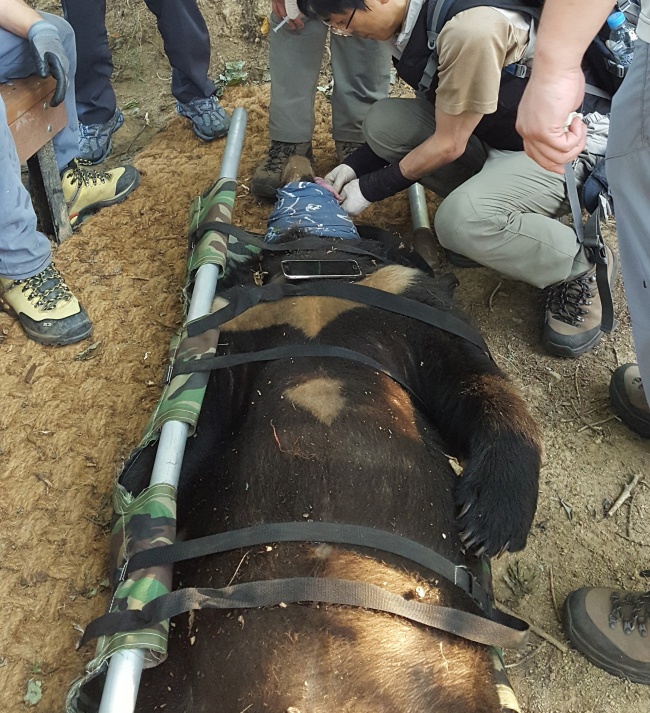Environment Ministry considers expanding habitats for endangered bears
By Jo He-rimPublished : Sept. 3, 2017 - 18:44
South Korea’s project to bring back endangered wild bears has been successful, but it has produced an unforeseen problem: runaway bears.
The Environment Ministry was to announce Monday what is to be done with a 2-year-old bear that has been in captivity for over a month after it escaped from its original habitat twice.
Tagged KM-53, the Asiatic black bear was found on Sudosan in North Gyeongsang Province, some 90 kilometers away from its original habitat on Jirisan in late July. As it was the bear’s second time being captured there, it has been disputed whether the bear should be allowed to settle in the new habitat.
The Environment Ministry was to announce Monday what is to be done with a 2-year-old bear that has been in captivity for over a month after it escaped from its original habitat twice.
Tagged KM-53, the Asiatic black bear was found on Sudosan in North Gyeongsang Province, some 90 kilometers away from its original habitat on Jirisan in late July. As it was the bear’s second time being captured there, it has been disputed whether the bear should be allowed to settle in the new habitat.

The bear was first released into a special protected area on Jirisan in 2015, 10 months after it was born in January that year. Due to the GPS failure of a chip implanted in the animal, his whereabouts had been unknown until he was caught on Sudosan in June for the first time this year.
The bear is believed to have passed through Hamyang and Geochang in South Gyeongsang Province to reach Sudosan, according to the ministry.
The animal’s move had surprised many, as the average typical radius of the species’ activities is less than 15 kilometers. The farthest that a black bear on Jirisan had gotten was to Hamyang in South Gyeongsang Province, which is 15 kilometers away.
Calls are rising for the quick release of the bear, which has been in captivity for over a month in a nature adaptation center on Jirisan, but opinions are sharply divided over the location of its release.
Environment activists say that the bear’s move is not a simple deviation, but its natural instinct to explore a new habitat. However, the government is worried about human safety and habitat protection.
Opponents calling for the bear to be returned to its original habitat argue that Sudosan is not equipped to protect endangered bears and that it could also put passers-by in danger due to possible encounters with the animals.
Park Bo-saeng, the mayor of Gimcheon City where the mountain is located, asked for the government to designate it as a natural habitat for the bears and promised “to create the best environment for the wild animal.”
The Ministry of Environment is still considering the best option, but agrees with the need to release KM-53.
“We are trying to release the bear as soon as we can, but nothing has been decided yet. It is very difficult to decide on the location because there are so many different opinions,” ministry official Kang Mi-jeong told The Korea Herald.
South Korea first released four bears on Jirisan in 2001, before its endangered species restoration project officially kicked off three years later. Now, there are 47 black bears living in the Jirisan area.
Considering that the receptive capacity of a natural habitat for black bears is thought to be 50, experts say it is time for the ministry to seriously consider expanding the area for the bears.
By Jo He-rim (herim@heraldcorp.com)








![[Graphic News] More Koreans say they plan long-distance trips this year](http://res.heraldm.com/phpwas/restmb_idxmake.php?idx=644&simg=/content/image/2024/04/17/20240417050828_0.gif&u=)
![[KH Explains] Hyundai's full hybrid edge to pay off amid slow transition to pure EVs](http://res.heraldm.com/phpwas/restmb_idxmake.php?idx=644&simg=/content/image/2024/04/18/20240418050645_0.jpg&u=20240419100350)






![[From the Scene] Monks, Buddhists hail return of remains of Buddhas](http://res.heraldm.com/phpwas/restmb_idxmake.php?idx=652&simg=/content/image/2024/04/19/20240419050617_0.jpg&u=20240419175937)

![[KH Explains] Hyundai's full hybrid edge to pay off amid slow transition to pure EVs](http://res.heraldm.com/phpwas/restmb_idxmake.php?idx=652&simg=/content/image/2024/04/18/20240418050645_0.jpg&u=20240419100350)

![[Today’s K-pop] Illit drops debut single remix](http://res.heraldm.com/phpwas/restmb_idxmake.php?idx=642&simg=/content/image/2024/04/19/20240419050612_0.jpg&u=)